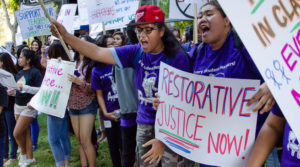Last month, a 20-year-old lad on a boozy night out in Coventry vandalised the famous bronze statue that adorns the front of Coventry Cathedral. ‘St Michael’s Victory over the Devil’ by Jacob Epstein depicts the saint, spear in hand, wings proudly unfurled, standing astride the Devil lying defeated on the floor.
Some seven metres in height, it’s a super-confident portrayal of the triumph of good over evil, made in 1958 by a Jewish sculptor who lived in London throughout the Nazi murder of Jews in Europe.
But Coventry Cathedral famously stands for a more nuanced way of dealing with wrongdoing. On November 14, 1940, much of the city centre — and, notably, its medieval cathedral — was destroyed by a massive air raid of 500 German bombers. The rebuilt landmark, which last year marked the 60th anniversary of its consecration, was intended as a sentinel of peace and forgiveness.
Carved into the red sandstone of the original cathedral’s bombed-out altar — and behind a replica Cross of Nails created from the destroyed building’s charred roof timbers — is an inscription in foot-high letters: “Father Forgive”.
The Cathedral, then, is home to a vigorous ministry of reconciliation. And it was in this same spirit that its authorities decided to deal with the man who vandalised their statue.
Instead of pressing charges, they arranged a meeting with the vandal. It would be an opportunity for him to take responsibility for his actions. As Canon Mary Gregory, the Canon for Arts and Reconciliation at Coventry, says: “It was not easy for the person who damaged the statue to come to the Cathedral and apologise. Instead of seeking revenge, we choose the more challenging path of forgiveness and growing understanding.”
A few miles south of the Cathedral is Finham Park School. They, like a great many schools around the country, have opted for a restorative justice approach to bad behaviour. According to Detective Inspector Stew Lewis from Coventry CID, “restorative justice is powerful in that in enables [victims] to speak directly to offenders about the harm their actions have caused, while allowing those responsible to show remorse and look to make amends”.
Practitioners of restorative justice believe punishment doesn’t work, and that words such as “consequences” are to be distrusted as euphemisms for crass retribution.
As someone who was regularly beaten at school from the age of seven, with the headmaster’s extensive collection of canes, and often going to bed with blood in my underpants, I have a deep, visceral, and not entirely rational, dislike of “consequences”. But I still can’t adjust myself to a school without any consequences — not least because I can’t work out what sort of protection this affords to those who are affected by the bad behaviour of others.
The big idea is that “RJ”, as it is known to its fans, offers a way of rebuilding relationships within the school community. Instead of a detention, misbehaving students are offered an opportunity for conversation or a meeting with their victims.
In the words of one teacher, “RJ is about getting students to understand the harm they have caused, rather than blaming them”. Retributive justice is concerned with punishment and penalty, restorative justice with restitution and restoring community relationships.
Sounds great. And RJ is not just increasingly popular in secondary education. In primary schools around the UK, “consequences” for bad behaviour are being replaced by restorative practices such as “circle time”, in which all parties are brought together in the round and invited to share their thoughts with the group.
Thus, the school bully is encouraged to meet the person they have bulled, to hear how the victim feels about what has been done to them, and to apologise for what they have done. The lion lays down with the lamb. Reconciliation is achieved without punishment.
Proponents argue restorative justice is a way of doing things with children, not to them. It is all about building collaborative behaviour between pupils and teachers. Not so much “this is my classroom and I’m in charge” from the teachers, but “this is our classroom”.
But… what if the bully enjoys this process? Gets a bit of a kick out of hearing the pain he has caused? What if he quietly smirks to himself, knowing that his charade of an apology is a frictionless fast-track back into school? What a travesty of justice this would be — the victim being re-bullied, within the very process that is meant to bring them some kind of resolution.
And the victim may not want to have to explain how the bullying made them feel. That is pretty exposing stuff, after all. I can imagine the victim coming away from such a meeting thinking that the whole school has secretly co-operated with the person who has made their life hell.
Do teachers really have the training, or the time, to replace punishment with some sort of quasi-therapeutic social environment? Daniel Buck, a teacher from the US, recently posted on Twitter:
“There were these two girls, one of them was from an abusive household, the other one her Dad had just died. They had a whole bunch of stuff going on in their lives and they kept nipping at each other, insulting each other online and bringing it to school. One of my administrators said: ‘Maybe you should sit down and have a restorative conversation with them”. I’m a 29-year-old dude with no training in counselling. You think that’s going to go well? Bringing up all of this really intense emotion, that’s going to end terribly. I don’t have the skill set for that. It’s probably very unethical, too, asking me to do something way outside of my training.”
But it’s not just the practical aspects of RJ that ought to be interrogated more deeply. There is a troubling philosophical aspect to it all.
Michel Foucault, the philosopher who made his name pointing out the iron fist of punishment inside the velvet glove of therapy and behaviour management, would have had a field day with the potential manipulations of restorative justice. His great 1975 book, Discipline and Punishment, begins with a contrast between two sorts of penal systems: that of the violent 18th century, with its tortures and executions, and the apparently more ‘humanitarian’ reform into prison and incarceration that comes about in the 19th century. But Foucault sees more than humanitarian progress here. He exposes the prison system as a deepening of control and the advent of a society dominated by surveillance.
Restorative justice can be understood in Foucauldian terms as the interiorisation of subjection. Something that looks more humanitarian and people-centred, but something that introduces subtle new forms of subjective domination. With RJ, the therapeutic circle becomes a new form of social discipline.
What makes me especially uncomfortable is the unleashing of all this psychological power — the therapeutic techniques, the mobilisation of shame — within primary schools where the children are so young, they are often unable to resist being manipulated. A small child being asked whether they want to accept the apology of their bully is so suggestible at that age, one really must question whether they have the emotional wherewithal to agree. Or, indeed, to apologise and seek restoration and forgiveness.
As with the Coventry example, forgiveness is the guiding spirit behind RJ. And when it happens properly, it is a beautiful thing. But it has to be carefully handled, and a healthy degree of scepticism is imperative. Any sense that the victim has some sort of obligation to forgive will create eddies of harm that radiate out.
Take an extreme example: imagine we introduced, however subtly, some sort of social expectation that victims of rape should find a way to forgive their attackers. Here, forgiveness can easily become another way of inflicting damage.
It is hard to know how deeply ensconced the philosophy of RJ has become in our school system. Local authorities like it partly because it lowers the number of school exclusions and relives them of the headache of having to make provision for excluded children. If bullies can say sorry and be “rehabilitated”, it probably saves the council a lot of money.
But is it working? At their most recent conference, the teaching union NASUWT reported that more than one in ten of their teachers had been physically assaulted by a pupil during the last year. They had also been subjected to pushing/shoving (22%), threats of physical assault (19%) and verbal abuse (58%).
It is easy to worry that the withdrawal of “consequences” in our schools is having very damaging consequences in the classroom. Indiscipline can affect a teacher’s confidence, leaving them feeling helpless and disempowered. The knock-on effects on lost teaching time are left to ripple silently across society.
Perhaps we need a touch more of St Michael’s robust attitude to the Devil than the punishment-averse psychology of restorative justice.
Disclaimer
Some of the posts we share are controversial and we do not necessarily agree with them in the whole extend. Sometimes we agree with the content or part of it but we do not agree with the narration or language. Nevertheless we find them somehow interesting, valuable and/or informative or we share them, because we strongly believe in freedom of speech, free press and journalism. We strongly encourage you to have a critical approach to all the content, do your own research and analysis to build your own opinion.
We would be glad to have your feedback.
Source: UnHerd Read the original article here: https://unherd.com/





